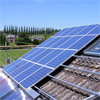Photovoltaic (PV) Panels convert solar energy into electrical energy. The PV cell consists of one or two layers of a semi conducting material, usually silicon. When light shines on the cell it creates an electric field across the layers causing electricity to flow. The greater the intensity of light, the greater the flow of electricity – some of the newly developed PV technologies can produce electricity on an overcast day. These are now common for such applications as powering parking meters, charging mobile phones/laptops, driving garden fountains etc.
The costs of installation are falling as demand rises, but costs still range from approximately £5,000 – £8000/kWp (kilowatt peak – the amount of energy they produce in full sunlight) including installation. Most domestic applications range from 1.5 – 3kWp – producing up to half an average domestic electricity bill each year.
With the Feed-in-Tariff legislation that was introduced in 2010, investment in Solar became extremely attractive as a long term investment. So much so, companies developed to install systems on your roof for free, making their return through the revenue from the Feed in Tariff.
The FIT works like this: The government (OFGEM) will make a 25 year contract to pay you a set rate per kilowatt hour produced (43.3 pence was set in April 2011), whether you use that electricity or not. If you are in your home with the lights on watching TV on a sunny day you may be using less electricity than you are generating from your roof and that electricity would be free, usually it would at least make some free contribution to your normal consumption. After that you can also sell the energy you don’t use to energy companies for them to sell to other customers. Up until recently it was a definate win-win-win situation for you, being an excellent investment with expected returns of approximately 8% per annum.
The FIT with initial tarrif level was set up before the last election to encourage rapid development of the industry and so make a major contribution to national low-carbon targets. Reductions in the rate over time was built in to the legislation as costs reduced via economies of scale, a review and adjustment being programmed for April 2011. Installers and purchasers had been geared to that date but, unfortunately for this new industry, the government has pulled the FIT tariff rate prematurely so that any installation after 9/12/11 (effectively) will receive half the current rate, to be confirmed following consultation at the end of the year. Our calculation of the return on the presently announced new rate can be found on our blog page and will be updated as information emerges.
Immediately there was a rush to bring forward orders taken before the announcement and predictions that after the cut off date 20,000 people will have to be made redundant.
All we can suggest is: Watch this space, PV installations may still be a good move when all settles down, but right now outcomes are uncertain.
For more information visit: http://en.wikipedia.org/wiki/Photovoltaics and http://wesupportsolar.net

